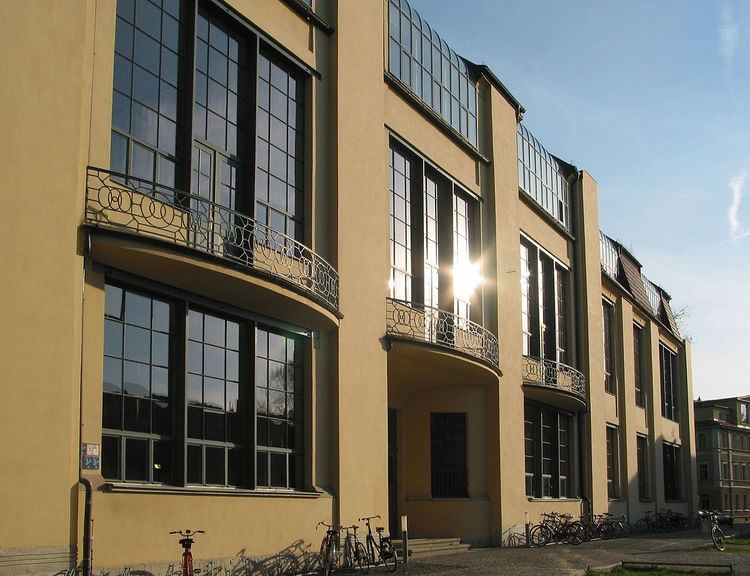The Weimar Saxon-Grand Ducal Art School (Großherzoglich-Sächsische Kunstschule Weimar) was created on October 1, 1860, by a decree of Charles Alexander, Grand Duke of Saxe-Weimar-Eisenach. It existed until 1910, at which time it was promoted to a "Hochschule". It should not be confused with the Weimar Princely Free Drawing School, which existed from 1776 to 1930 and, after 1860, served as a preparatory school.
From 1870 to 1900, the students and teachers of the school turned away from the academic tradition of idealized compositions. Inspired by the Barbizon School, they went directly to nature for their inspiration, in genre as well as landscape painting. This approach set the school apart and attracted attention throughout Europe.
The follower, the Grand Ducal Saxon School of Visual Arts of Weimar
In 1910, William Ernest, Grand Duke of Saxe-Weimar-Eisenach, in cooperation with Hans Olde (Director of the Art School), Adolf Brütt (Director of the Sculpture School) and Henry van de Velde (Director of the School of Arts & Crafts), joined the three schools to create a new Hochschule: The "Grand Ducal Saxon School of Visual Arts in Weimar", headed by Fritz Mackensen. Several more transformations led to the school's becoming part of the Bauhaus-University Weimar.
The Art School Building (also called the "Studio Building") was constructed in two phases: 1904/05 and 1911, on the former Art School Road from plans drawn up by Henry van de Velde. Both buildings are true to the principles of Jugendstil regarding functionality and appropriate use of materials. As the founding place of the Bauhaus movement, it has been one of the most important arts schools of the century. Of particular note in the building's interior are the Oberlichtsaal (skylight hall), the elliptical staircase and the statue of Eve by Auguste Rodin.
In December 1996, the building (together with the former Arts & Crafts School) was designated a UNESCO World Heritage Site. In 1999, it was restored to an approximation of its original appearance by architect Thomas van den Valentyn and his team. This restoration included the "Gropiuszimmer"; the room that served as Walter Gropius' office when he was the director, which was returned to its former state, c.1925. The building now houses the School of Architecture, the Design Department, the Dean's office and the Rector's office.
Directors and lecturers
By date of appointment.
Carl Arp, Hans Arp, Paul Baum, Max Beckmann, Ella Bergmann-Michel, Hugo L. Braune, Ferdinand Brütt, Karl Buchholz, Julius Victor Carstens, Paul Eduard Crodel, Hans Delbrück, Mathilde Freiin von Freytag-Loringhoven, Ludwig von Gleichen-Rußwurm, Karl Gussow, August Haake, Wilhelm Hasemann, Ivo Hauptmann, Rudolf Höckner, Otto Illies, Leopold Graf von Kalckreuth, Otto von Kameke, Fritz Lattke, Max Liebermann, Carl Malchin, Carlo Mense, Benedikt Momme Nissen, Eduard Morres, Alexander Olbricht, Otto Piltz, Leon Pohle, Harriet von Rathlef-Keilmann, Adolf Rettelbusch, Christian Rohlfs, Paul Thumann, Minna Beckmann-Tube, Eduard Weichberger, Erich Windbichler, Adolf Ziegler.
Walther Scheidig: Die Weimarer Malerschule. Seemann, Leipzig 1991, ISBN 3-363-00538-5.
Hendrik Ziegler: Die Kunst der Weimarer Malerschule. Von der Pleinairmalerei zum Impressionismus. Böhlau, Köln, Weimar, Wien 2001, ISBN 3-412-15400-8.
Gerda Wendemann et al.: Hinaus in die Natur: Barbizon, die Weimarer Malerschule und der Aufbruch zum Impressionismus. Christoph Kerber Verlag, Bielefeld 2010, ISBN 978-3-8667-8381-2.
Jutta Hülsewig-Johnen, Thomas Kellein: Der Deutsche Impressionismus. DuMont-Buchverlag, Köln 2009, ISBN 978-3-8321-9274-7.
Renate Müller-Krumbach, Karl Schawelka, Norbert Korrek, Gerwin Zohlen: Die Belebung des Stoffes durch die Form. Van de Veldes Hochschulbau in Weimar. Verlag der Bauhaus-Universität Weimar, Weimar 2002, ISBN 978-3-86068-166-4.
Silke Opitz (Hrsg.): Van de Veldes Kunstschulbauten in Weimar. Architektur und Ausstattung. Verlag der Bauhaus-Universität Weimar, Weimar 2004, ISBN 3-86068-201-6.
Michael Eckhardt (Hrsg.): Bauhaus-Spaziergang. In Weimar unterwegs auf den Spuren des frühen Bauhauses. Verlag der Bauhaus-Universität Weimar, Weimar 2009, ISBN 978-3-86068-378-1.
Frank Simon-Ritz, Klaus-Jürgen Winkler, Gerd Zimmermann (Hrsg.): Aber wir sind! Wir wollen! Und wir schaffen! Von der Großherzoglichen Kunstschule zur Bauhaus-Universität. Verlag der Bauhaus-Universität Weimar, Weimar 2010, ISBN 978-3-86068-419-1.
Schlenker, Sabine (2007): Mit dem Talent der Augen. Der Kunstkritiker Emil Heilbut (1861-1921) Ein Streiter für die moderne Kunst im Deutschen Kaiserreich, VDG-Verlag Weimar, ISBN 978-3-89739-563-3.
Müllerschön, Bernd und Maier, Thomas (2002): Die Maler der Schule von Barbizon – Wegbereiter des Impressionismus, Ed. Thombe, ISBN 978-3-93525201-0.
Stapf, Peter (2014): Der Maler Max Thedy 1858–1924, Böhlau Verlag Köln∙Weimar∙Wien, ISBN 978-3-412-22264-2.
Fuß, Rowena (2013): Christian Rohlfs in Weimar: Das Frühwerk: 1870-1901 (Vorreiter ohne Vorbild), VDG-Verlag Weimar, ISBN 978-3-8973-9791-0.
Plaul, Jens M. (2009): Max Oehler: Auf den Spuren eines Landschaftsmalers in Nachfolge der Weimarer Malerschule, 2. Auflage, Arbeitskreis Stadtgeschichte Blankenhain, ISBN 978-3-0000-4335-2
Merseburger, Peter (2013): Mythos Weimar: Zwischen Geist und Macht, Pantheon Verlag München, ISBN 978-3-5705-5208-7.
Häder, Ulf (1999): Der Jungbrunnen für die Malerei, Holland und die deutsche Kunst 1850–1900, page 168–171 and 286. Jena.
Mai, Ekkehard (2010): Die Deutschen Kunstakademien im 19. Jahrhundert, Künstlerausbildung zwischen Tradition und Avantgarde, Böhlau Verlag Köln Weimar Wien, ISBN 978-3 412-20498-3.
Whitford, Frank (1984): Bauhaus (Wold of Art), Thames and Hudson Ltd., London, ISBN 978-0-500-20193-0
Seemann, E.A. (2000): Karl Buchholz, 1849-1889: Ein Künstler der Weimarer Malerschule, Seemann-Verlag, ISBN 978-3-363-00733-6.
Dauer, Horst (1983): Die Weimarer Malerschule, Leipzig, Seemann-Verlag, ASIN B0026OK8UA.
Deshmukh, Marion F. (2015): Max Liebermann Modern Art and Modern Germany, Ashgate Farnham, ISBN 978-1-4724-3415-9.

